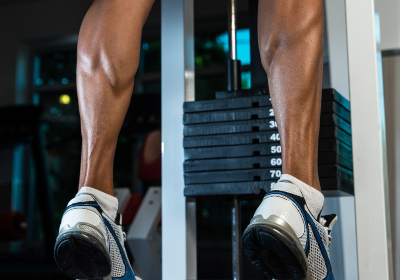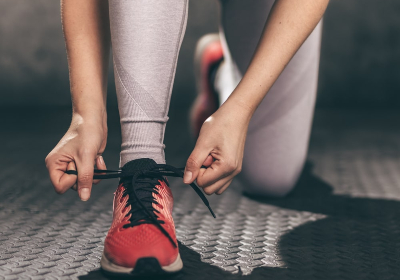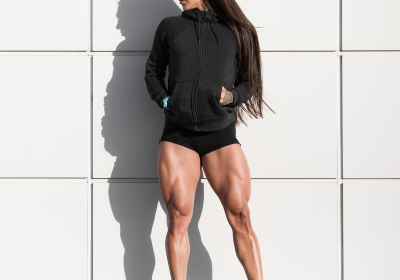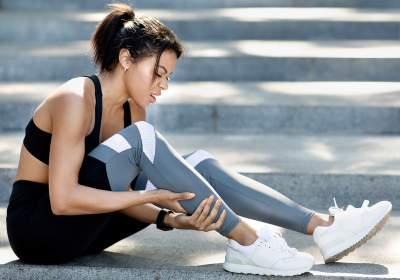VIDEO
RECOMMENDED FOR YOU
ARTICLES
Building up the calf muscles and make your legs beautiful is quite difficult, but possible. It is difficult because the legs are used to constant strain (usually people walk a lot). And it becomes possible thanks to the proven exercises, which can effectively train this group of muscles. In this article, we will take a detailed look at the anatomy of calves, their functions, and exercises that you can do to help make them stronger.
The calf muscle is the most superficially located muscle of the lower leg that crosses two joints: the knee and ankle. Like the biceps of the shoulder, it consists of two heads: medial (located closer to the inside of the tibia) and lateral (located closer to the outside of the tibia). It is interesting to note, that about 5.5% of Japanese and about 3% of people of other nationalities may have the 3rd head of the calf muscle, which attaches from above between the fixation sites of the medial and lateral heads, and may connect from below either to the lateral head (less often) or to the medial head (more often).
The primary function of the calf muscle is to lift the supporting leg, which causes a person to move forward along with flexion of the knee and ankle joints. Running causes a lot of stress on the calf muscles that is why many sprinters face the problem of calf pain.
There are also other functions of the calf muscle.
The calf muscle is involved in the plantar flexion of the foot, which occurs during walking, running, or cycling;
It is also activated during flexion of the leg at the knee joint;
It participates in the supination of the foot (its outward rotation);
The calf muscle takes part in the stabilization of the knee and ankle joints and also helps to keep the balance in the upright position of the body.
There are many reasons that can cause calf pain. And to prevent this unpleasant situation, the following rules should be followed:
running at a comfortable pace;
warming up before running and stretching after training;
comfortable shoes suitable for running;
a smooth transition from running to stopping after a step;
drinking plenty of water after the workout;
a warm shower/bath and a massage to relax the muscles.
The reasons why the calf muscles are not as developed as you would like them to be could be the following:
too much training aimed at working out this muscle group;
not enough exercise;
the wrong set of exercises.
It is necessary to choose the right exercises for the calf muscles. It must be noted that the surface muscle is worked out in a standing position, and the cambalic muscle in a sitting position. To train as effectively as possible, it is necessary to load both muscles.
And the last, but not the least advice: do not try to achieve serious results by performing endless repetitions, such as deadlifts. The main secret of how to pump up the calf muscles is heavy training with weights. It is recommended to train your calves no more than 2 times a week.
Read more
In bodybuilding and fitness, the deltoid muscles play a special part. Despite the fact that the muscle area belongs to small groups, it is second only to the biceps in terms of training frequency. The reason lies not only in the importance of the deltoid muscles in the anatomy but also in improving the aesthetics of the figure. Understanding the functions and features of the deltoid bands allows you to maximize the effectiveness of the training process and significantly reduce the injury risk.
The deltoid muscles consist of three heads (bundles):
The anterior head (anterior bundle) attaches to the humerus and is responsible for lifting the arm forward.
The middle head (lateral bundle) is attached to the acromion of the scapula and allows the arm to be lifted sideways.
The posterior head (posterior bundle) is attached to the scapula and allows the arm to be moved backward.
The deltoid muscle covers the shoulder joint. The muscle is thick, triangular in shape, with the base up and the apex down. It consists of large muscle bundles, which fan-like converge at the apex. It starts from the clavicle and scapula and attaches to the deltoid tuberosity of the humerus.
In training the deltoid muscles, it is very important to pump all three bundles equally. This will protect the shoulder joint from injuries.
The deltoid muscle bundles have different functions, so you cannot work them all with just one exercise: you must include at least three movements in your workout.
You must correctly select exercises for pumping the front, middle and rear bundles. Choose one exercise from each category and add them to your workouts.
Shoulders should be trained no more than twice a week (once is enough for beginners), this will allow the muscles to fully recover for the next workout.
Here is some basic exercises for deltoids:
The army bench press or barbell/dumbbell press in standing or sitting position (middle, front).
Bench press from behind the head while seated (middle, front).
Chin-up or 'broach' barbell pull (middle, front).
Lee Heini pulls (back, middle).
Arnold press (front, middle).
Read more
The anatomy of the human foot is complex. This is a part of the leg with many muscular compartments that perform functions such as balancing, maintaining stability, softening the impact of steps, creating solid support. Its structure allows us to see how evolution has adapted our body to an efficient way of movement - upright walking. Anatomically, it is similar to the hand.
The anatomical structure of the foot is quite complex, due to the need for a small support area to support the weight of the human body. There are two parts distinguished in the foot: a plantar surface (which is in direct contact with the ground) and an opposite - dorsiflexion.
All parts of this very complex mechanism work together to provide us with balance when we walk and exercise.
The lower part of the limb is built from bones of different sizes connected into a single structure. It allows the weight of the body to be supported when moving and is capable of bearing enormous loads.
The bones of the fingers include fourteen phalanges and their connecting articulations. Each finger is formed of three phalanges, except for the thumb, which contains two. They are connected with the parts of the skeleton forming the metatarsus through the articular cartilage. The function of the toes is to distribute the weight of the body equally and to improve balance.
The foot includes sesamoid bones. These are small formations of rounded shape, their number is individual. And there are people who do not have these bones. Their option is to increase the curvature of the transverse arch.
The muscles on the dorsal side are responsible for extending the toes and foot.
The plantar side muscles are responsible for their flexion.
They play an important role in the formation of the correct arch and take on a huge load when moving and jumping.
Everyone needs to take care of their feet, not just people who like to run. Problems can arise from a sedentary lifestyle, excessive weight, or constant work 'on your feet'. The most common problem is flat feet. It can be not only congenital but also acquired at any age. Because of changes in the arch of the foot loses cushioning, while walking, shock load is transferred to other joints, causing problems in the knees and lower back.
You can avoid ankle pathologies and injuries if you do special exercises. We have collected the best, in our opinion, sets of exercises to strengthen the foot, its muscles, ligaments, and joints. You do not have to do everything just choose exercises that you like, make your own complexes. Training your feet even 1-2 times a week will help prevent injuries, become more athletic and run faster.
Read more
One of the most important running muscles is the quadriceps - the large muscle at the front of the thigh. It has been scientifically proven that regular strength training improves workout performance and reduces the risk of injury, as well as strengthens your back, and leg muscles, making your running more productive.
The quads, also known as the quadriceps muscle, is a group of muscles located at the front of the leg above the knee. It is one of the largest and strongest muscles in your body that consists of four heads: fastus medialis (medial wide), vastus intermedius (intermediate wide), vastus lateralis (lateral), and rectus femoris (straight thigh muscle). Almost every action performed by the legs involves two or more heads of the quadriceps. The quadriceps muscle plays an important role at the beginning of the movement (quick start) and during ascent and descent in elevated positions - which is why you may experience painful sensations in this area of the leg after an intense uphill workout.
According to researchers at the University of Delaware, strong quadriceps act as cushioning and can protect the knees and the entire musculature of the hip from common running injuries. Often many runners are injured because they have weak and underdeveloped quadriceps, so it is especially important to strengthen them.
By training and strengthening the quads, you can get the following benefits when running:
Increased speed. Strong quadriceps help you tackle steep hills and climbs more easily and make pushing off the ground more powerful, resulting in increased speed.
Reduced injuries. According to research, poorly developed quadriceps are often associated with many running injuries. For example, a common injury such as the 'runner`s knee' results from weakness in these muscles, which are unable to stabilize the knee joint during the movement.
Increased endurance. Strengthening the quadriceps muscle will make your running more effortless and efficient, which contributes to increased running volume and endurance.
Training
The quadriceps occupy 70% of the muscle mass of the leg, so it is their development that is fundamental in leg training. The main exercise for developing the quadriceps is the squat. But, for beginners, at the first stages of training, it is better to start with leg curls sitting in an exercise machine, leg press, and hyperextensions to strengthen the lower back, to avoid injuries, in order to prepare the base for the heavy squats. It is a good idea to include squats in your training plan after about six months of training.
Read more
Our feet and ankles are one of the most important elements of the locomotor system: without them we can neither stand, walk, run, nor kick someone in the face. Unfortunately, their condition is very often neglected.
Strong and flexible legs provide the basis for stable movement and are of primary importance for performing our daily activities without pain or strain.
The ankle is a block-shaped joint formed by the articular surfaces of the distal ends of the tibia and fibula and the articular surface of the Talus block. Both tibia bones are connected by ligaments and form a kind of fork covering the upper and lateral surfaces of the talus body. The articular sac is reinforced by ligaments.
Many of them connect the bones to each other to provide stability, along with various muscles from the calf to the small tendons that move your toes.
The posterior aspect of the ankle is reinforced by the Achilles tendon, the strongest and most powerful muscle in the human body, which originates at the fusion of the calf and the cambal muscles and is connected to the calcaneus tuberosity.
The ankle joint has to support the weight of the human body and ensure that it is properly distributed when you walk. Therefore, the strength of the ligamentous apparatus, cartilage, and bone tissue is important.
Often people complain of tightness in the muscles of the legs and especially the lower leg. If the small muscles are too weak to keep the foot in the right position, the body responds by increasing tension, elsewhere, in the larger muscles. This leads to tightness in the shin and ankle. Stretching can help for a while, but in the long run, only strengthening the foot is the optimal solution.
Surely everyone who knows about running firsthand knows the importance of strengthening the ligaments of the foot and ankle. Another thing is that sometimes it's hard to spare even 5-10 minutes of training for foot exercises: we get dressed, tie our shoelaces - and run out into the street. That's a pity. After all, good elastic ligaments reduce the risk of foot pain.
Properly fitting shoes is a necessary but not sufficient condition for proper body alignment during running and after training. The ligaments and muscles of the foot can only be strengthened by special exercises.
Read more
SAVE TO ...





